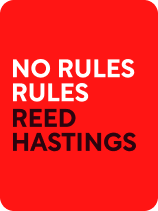

This article is an excerpt from the Shortform book guide to "No Rules Rules" by Reed Hastings. Shortform has the world's best summaries and analyses of books you should be reading.
Like this article? Sign up for a free trial here .
What is the Netflix innovation strategy? How does it apply to the management of staff within Netflix?
The Netflix innovation strategy relies on securing high performers and empowering these employees to act on their talents and insights. These people are best at what they do, and by allowing them the freedom to do it well, Netflix is able to stay innovative and competitive.
Keep reading for more about how employees play into the Netflix innovation strategy.
Netflix Innovation Strategy
When Netflix launched in 1997, the company was basically a mail-order version of Blockbuster, the video rental store that dominated the home entertainment industry at the time. Instead of going to a store to pick out rentals of movies and television series, Netflix users received their DVDs by mail and sent them back when they were finished. Today, Netflix not only streams movies and TV shows but also produces its own award-winning content. The company has more than 167 million subscribers across 190 countries, its stock price rose from $1 in 2002 to $350 in 2019, and it’s consistently listed among the best places to work.
To achieve this level of success, Netflix had to adapt and thrive in a rapidly changing industry. The company made four major evolutions in the span of just 15 years:
- From mailing DVDs to streaming content online
- From streaming existing movies and shows to debuting original content (such as House of Cards and Orange Is the New Black) produced by third-party studios
- From contracting with outside studios to building a studio to produce original content in-house (such as Stranger Things and The Ballad of Buster Scruggs)
- From a domestic business to a global company
The keys to Netflix’s success have been unconventional business practices. Specifically, the Netflix innovation strategy focuses on:
- Hiring and keeping only the best workers—at any cost
- Promoting candor through constant feedback at all levels as well as organizational transparency
- Removing controls, such as allotted vacation time and approval processes
These practices have created a company culture that focuses on empowering employees to innovate and take accountability, rather than conditioning them to simply follow protocol. In this book, Netflix CEO Reed Hastings and Erin Meyer, a business professor and author, tell the story of Netflix’s evolution, and they illustrate how these unusual business practices shaped the company’s success. Hastings provides his first-person account of the events, as well as his reasoning for cultivating this kind of culture, while Meyer adds context with data about other companies’ business practices and excerpts from interviews with hundreds of current and former Netflix employees.
We will explore how Hastings and his team implemented the three business practices above—maintaining a high-performing workforce, promoting transparency, and removing controls. These are all important to the Netflix innovation strategy.
High-Performing Workforce
One study showed that a single low performer brings an entire team’s productivity down by 30 to 40 percent. In the experiment, college students were grouped in teams of four to perform a task in 45 minutes—but the students didn’t know that each team included an actor who was assigned to play the role of a jerk, a slacker, or a depressive pessimist. Regardless of the talents of the rest of the group, by the end of the session, each team had adopted the attitude of its bad apple: The jerk’s teammates were insulting each other, the slacker’s teammates had given up on the task, and the pessimist’s teammates had deflated and lay their heads down on their desks.
By contrast, as Hastings discovered, a team full of highly talented people pushes everyone’s performance up. Hastings vowed to hire only the best employees, and, in Chapters 4 and 7, we’ll discuss how he reinforced this principle by paying top dollar to keep great employees and training managers to identify and let go of anyone—from receptionists to executives—who fell below that standard. To cultivate the adaptive, innovative culture Netflix needed, Hastings created a high-performing workforce that provided the foundation.
The Netflix innovation strategy in hiring led to a lean, high-performing workforce, which increased the speed of innovation and output. Additionally, there were two major benefits for managers:
- It was easier to manage high-performing employees than to corral merely adequate employees.
- It was easier to manage a smaller workforce.
Empowering Employees
In most companies, all big decisions must pass through the higher-ups. However, managers and executives are not necessarily the most qualified to make decisions on everything from marketing strategies to financial structuring—that’s why they have competent staff to lead those efforts. When one or a handful of company leaders has the final say-so on everything, their lack of vision or fixed perspective can severely limit innovation. Additionally, running every decision up the chain of command slows progress and growth, and if the boss shoots down an idea, employees have to spend even more time developing a new proposal.
By contrast, the Netflix innovation strategy follows a model of dispersed decision-making, which empowers lower-level employees to make decisions and own the consequences, rather than seeking approval from managers.
Dispersed decision-making is critical for companies like Netflix, where creative innovation is the key to adapting and staying relevant (as opposed to industries like medicine, where error prevention is the top priority). This structure is only possible with the foundation of high talent density and a culture of candor and radical transparency. In order for managers to feel confident watching employees forge ahead against their advice, they must believe in the competence of that employee and they must rest assured that their equally competent colleagues will candidly share feedback on the proposal. Yet, even with those elements, managers must be trained to refrain from overriding decisions they disagree with.

———End of Preview———
Like what you just read? Read the rest of the world's best book summary and analysis of Reed Hastings's "No Rules Rules" at Shortform .
Here's what you'll find in our full No Rules Rules summary :
- How Netflix achieved massive success in a short period of time
- The unusual business practices that have helped Netflix sustain its success
- Why Netflix fires adequate employees






